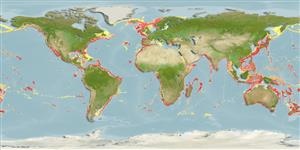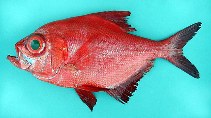Beryx decadactylus Cuvier, 1829
Alfonsino
Add your observation in Fish Watcher
| Native range | All suitable habitat | Point map | Year 2050 |

|
| This map was computer-generated and has not yet been reviewed. |
| Beryx decadactylus AquaMaps Data sources: GBIF OBIS |
Upload your photos and videos
Pictures | Google imageBeryx decadactylus
Female picture by Cambraia Duarte, P.M.N. (c)ImagDOP
Pictures | Google imageBeryx decadactylus
Female picture by Cambraia Duarte, P.M.N. (c)ImagDOP
Portugal country information
Common names:
Alfonsim, Alfonsim-da-costa-larga, Alfonsino
Occurrence: native
Salinity: marine
Abundance: | Ref:
Importance: | Ref:
Aquaculture: | Ref:
Regulations: | Ref:
Uses: no uses
Comments:
National Checklist: Portugal
Country Information: https://www.cia.gov/library/publications/resources/the-world-factbook/geos/po.html
National Fisheries Authority:
Occurrences: Occurrences Point map
Main Ref: Maul, G.E., 1986
National Database: Portuguese Freshwater Fishes
Occurrence: native
Salinity: marine
Abundance: | Ref:
Importance: | Ref:
Aquaculture: | Ref:
Regulations: | Ref:
Uses: no uses
Comments:
National Checklist: Portugal
Country Information: https://www.cia.gov/library/publications/resources/the-world-factbook/geos/po.html
National Fisheries Authority:
Occurrences: Occurrences Point map
Main Ref: Maul, G.E., 1986
National Database: Portuguese Freshwater Fishes
Common names from other countries
Classification / Names Tên thường gặp | Các synonym ( Các tên trùng) | Catalog of Fishes(Giống, Các loài) | ITIS | CoL | WoRMS | Cloffa
> Beryciformes (Sawbellies) > Berycidae (Alfonsinos)
Etymology: Beryx: Greek, beryx or berys = a name of a fish. Cuvier & Valenciennes (1829:221) precise that the name was used by Gesner from Varinus, but with no indication whatsoever helping identifying any species. After D'Arcy Wentworth Thompson (A glossary of Greek fishes, 1947), the name actually seems to come originally from Hesychius, but perhaps the name was not originally a fish name. Thompson compares it to meryx (ruminant), applied on skaros (Scarus), so it may have been applied on a parrot fish referring to its browsing/grazing behavior described by Aristoteles and followers.
More on author: Cuvier.
Etymology: Beryx: Greek, beryx or berys = a name of a fish. Cuvier & Valenciennes (1829:221) precise that the name was used by Gesner from Varinus, but with no indication whatsoever helping identifying any species. After D'Arcy Wentworth Thompson (A glossary of Greek fishes, 1947), the name actually seems to come originally from Hesychius, but perhaps the name was not originally a fish name. Thompson compares it to meryx (ruminant), applied on skaros (Scarus), so it may have been applied on a parrot fish referring to its browsing/grazing behavior described by Aristoteles and followers.
More on author: Cuvier.
Environment: milieu / climate zone / depth range / distribution range Sinh thái học
Biển Tầng đáy biển sâu; Mức độ sâu 110 - 1300 m (Ref. 126224), usually 200 - 800 m (Ref. 126224). Deep-water; 70°N - 48°S, 180°W - 180°E
Sự phân bố Các nước | Các khu vực của FAO | Các hệ sinh thái | Những lần xuất hiện | Point map | Những chỉ dẫn | Faunafri
Worldwide in temperate and tropical latitudes, except the eastern Pacific. Eastern Atlantic: Greenland, Iceland, and Norway to Western Sahara and South Africa, including western Mediterranean. Western Atlantic: south to Brazil. Also found in Argentine (Ref. 2806). Indo-Pacific: East Africa (including the Madascar Ridge and Saya de Malha Bank, Ref. 33390) to Japan, Australia, and New Zealand (Ref. 5755). The limited number of records in the western Pacific is doubtless the result of limited fishing effort below 200 m (Ref. 9833).
Length at first maturity / Bộ gần gũi / Khối lượng (Trọng lượng) / Age
Maturity: Lm 27.6 range ? - ? cm
Max length : 100.0 cm TL con đực/không giới tính; (Ref. 26340); common length : 35.0 cm TL con đực/không giới tính; (Ref. 9833); Khối lượng cực đại được công bố: 4.0 kg (Ref. 126224); Tuổi cực đại được báo cáo: 69 các năm (Ref. 86253)
Max length : 100.0 cm TL con đực/không giới tính; (Ref. 26340); common length : 35.0 cm TL con đực/không giới tính; (Ref. 9833); Khối lượng cực đại được công bố: 4.0 kg (Ref. 126224); Tuổi cực đại được báo cáo: 69 các năm (Ref. 86253)
Short description Khóa để định loại | Hình thái học | Sinh trắc học
Các tia vây lưng cứng (tổng cộng) : 4; Các vây lưng mềm (tổng cộng) : 18 - 20; Tia cứng vây hậu môn: 4; Tia mềm vây hậu môn: 25 - 30. Body deep, compressed and has a large eye. Top of head, iris, back and all fins bright blood red. Orbital bones, cheeks and opercular bones shiny white. Breast shiny yellowish white. Body silvery with thin lengthwise lines (Ref. 37108).
Found in ca. 500 m on mud or sandy mud bottom (Ref. 11230). Occurs on the continental slope; adults demersal, young pelagic (Ref. 9563). Feeds on crustaceans, small fishes and cephalopods (Ref. 3321). A 35 cm SL specimen was found in the stomach of Latimeria (Ref. 58472). Young have heavy spines on the head (Ref. 35388).
Life cycle and mating behavior Chín muồi sinh dục | Sự tái sinh sản | Đẻ trứng | Các trứng | Sự sinh sản | Ấu trùng
Main reference
Upload your references | Các tài liệu tham khảo | Người điều phối | Người cộng tác
Maul, G.E., 1990. Berycidae. p. 626. In J.C. Quero, J.C. Hureau, C. Karrer, A. Post and L. Saldanha (eds.) Check-list of the fishes of the eastern tropical Atlantic (CLOFETA). JNICT, Lisbon; SEI, Paris; and UNESCO, Paris. Vol. 2. (Ref. 7413)
IUCN Red List Status (Ref. 130435: Version 2024-1)
Least Concern (LC) ; Date assessed: 29 January 2013
Threat to humans
Harmless
Human uses
Các nghề cá: Tính thương mại
FAO(Các nghề cá: Sản xuất; publication : search) | FishSource | Biển chung quanh ta
Thêm thông tin
Trophic ecology
Các loại thức ăn
Thành phần thức ăn
Thành phần thức ăn
Food rations
Các động vật ăn mồi
Các loại thức ăn
Thành phần thức ăn
Thành phần thức ăn
Food rations
Các động vật ăn mồi
Population dynamics
Growth parameters
Max. ages / sizes
Length-weight rel.
Length-length rel.
Length-frequencies
Mass conversion
Bổ xung
Sự phong phú
Growth parameters
Max. ages / sizes
Length-weight rel.
Length-length rel.
Length-frequencies
Mass conversion
Bổ xung
Sự phong phú
Life cycle
Sự tái sinh sản
Chín muồi sinh dục
Sự sinh sản
Đẻ trứng
Spawning aggregations
Các trứng
Egg development
Ấu trùng
Sự biến động ấu trùng
Sự tái sinh sản
Chín muồi sinh dục
Sự sinh sản
Đẻ trứng
Spawning aggregations
Các trứng
Egg development
Ấu trùng
Sự biến động ấu trùng
Distribution
Các nước
Các khu vực của FAO
Các hệ sinh thái
Những lần xuất hiện
Những chỉ dẫn
BRUVS - Videos
Các nước
Các khu vực của FAO
Các hệ sinh thái
Những lần xuất hiện
Những chỉ dẫn
BRUVS - Videos
Physiology
Body composition
Nutrients
Thành phần ô-xy
Dạng bơi
Tốc độ bơi
Visual pigments
Fish sound
Diseases & Parasites
Toxicity (LC50s)
Body composition
Nutrients
Thành phần ô-xy
Dạng bơi
Tốc độ bơi
Visual pigments
Fish sound
Diseases & Parasites
Toxicity (LC50s)
Genetics
Di truyền
Heterozygosity
Di sản
Di truyền
Heterozygosity
Di sản
Human related
Aquaculture systems
Các tổng quan nuôi trồng thủy sản
Các giống
Ciguatera cases
Stamps, coins, misc.
Aquaculture systems
Các tổng quan nuôi trồng thủy sản
Các giống
Ciguatera cases
Stamps, coins, misc.
Các công cụ
E-book | Hướng dẫn hiện trường | Khóa để định loại | Tần suất chiều dài Wizard | Công cụ của vòng đời | Bản đồ điểm | Classification Tree
| Catch-MSY |
Special reports
Download XML
Các nguồn internet
Aquatic Commons | BHL | Cloffa | BOLDSystems | Websites from users | Check FishWatcher | CISTI | Catalog of Fishes(Giống, Các loài) | DiscoverLife | ECOTOX | Faunafri | Fishtrace | GenBank(genome, nucleotide) | GloBI | GOBASE | | Google Books | Google Scholar | Google | IGFA World Record | MitoFish | Các cơ sở dữ liệu quốc gia | Otolith Atlas of Taiwan Fishes | PubMed | Reef Life Survey | Scirus | SeaLifeBase | Cây Đời sống | Wikipedia(Go, tìm) | World Records Freshwater Fishing | Zoobank | Tạp chí Zoological Record
Estimates based on models
Preferred temperature (Ref. 115969): 4.5 - 18.3, mean 11.2 (based on 1031 cells).
Phylogenetic diversity index (Ref. 82804): PD50 = 0.6260 [Uniqueness, from 0.5 = low to 2.0 = high].
Bayesian length-weight: a=0.01445 (0.00900 - 0.02322), b=3.05 (2.91 - 3.19), in cm Total Length, based on LWR estimates for this species & (Sub)family-body (Ref. 93245).
Mức dinh dưỡng (Ref. 69278): 4.1 ±0.76 se; based on food items.
Thích nghi nhanh (Ref. 120179): thấp, thời gian nhân đôi của chủng quần tối thiểu là 4.5 - 14 năm (K = 0.11-0.16; tmax >11).
Fishing Vulnerability (Ref. 59153): High to very high vulnerability (69 of 100).
Climate Vulnerability (Ref. 125649): High vulnerability (62 of 100).




